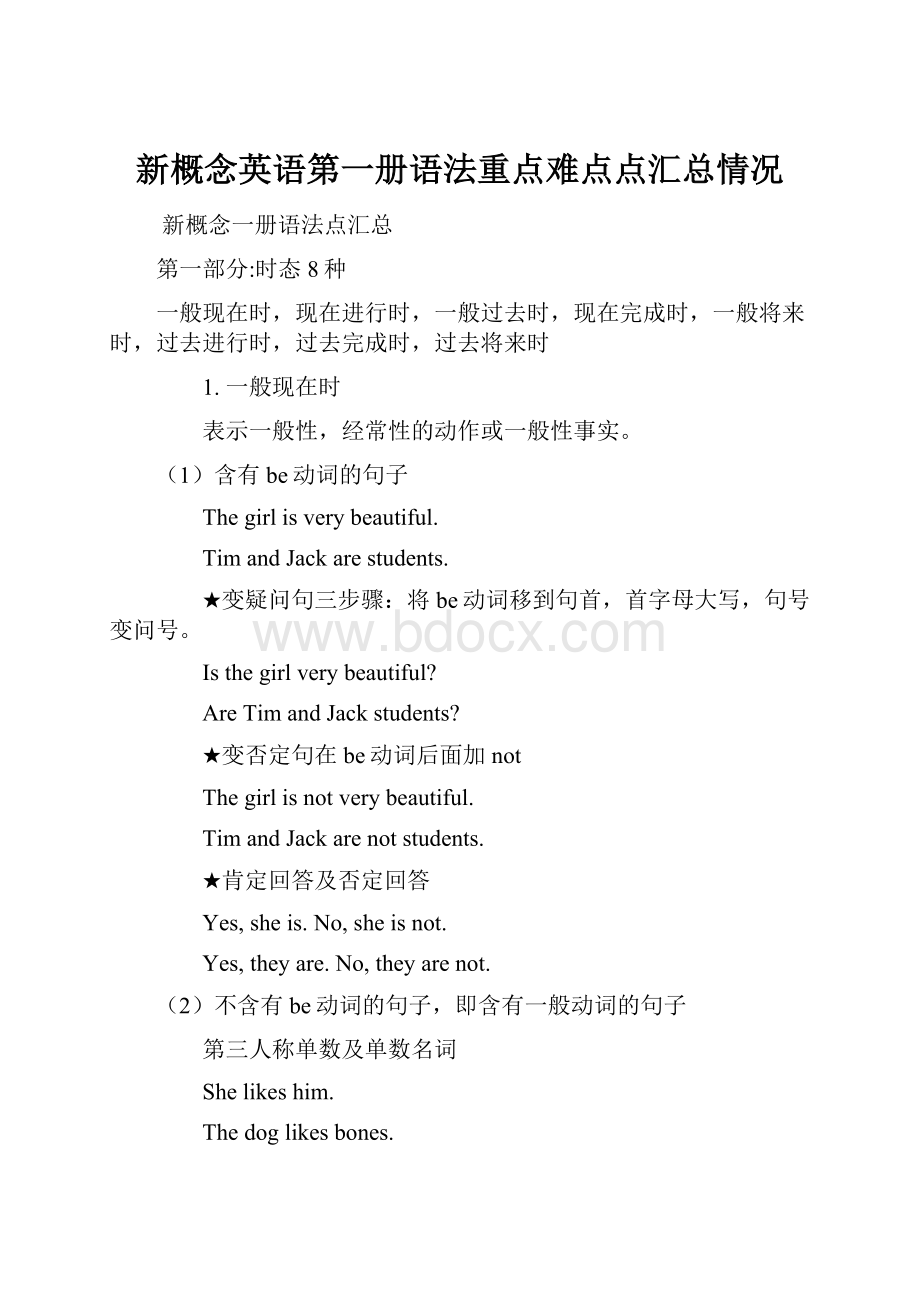新概念英语第一册语法重点难点点汇总情况.docx
《新概念英语第一册语法重点难点点汇总情况.docx》由会员分享,可在线阅读,更多相关《新概念英语第一册语法重点难点点汇总情况.docx(29页珍藏版)》请在冰豆网上搜索。

新概念英语第一册语法重点难点点汇总情况
新概念一册语法点汇总
第一部分:
时态8种
一般现在时,现在进行时,一般过去时,现在完成时,一般将来时,过去进行时,过去完成时,过去将来时
1.一般现在时
表示一般性,经常性的动作或一般性事实。
(1)含有be动词的句子
Thegirlisverybeautiful.
TimandJackarestudents.
★变疑问句三步骤:
将be动词移到句首,首字母大写,句号变问号。
Isthegirlverybeautiful?
AreTimandJackstudents?
★变否定句在be动词后面加not
Thegirlisnotverybeautiful.
TimandJackarenotstudents.
★肯定回答及否定回答
Yes,sheis.No,sheisnot.
Yes,theyare.No,theyarenot.
(2)不含有be动词的句子,即含有一般动词的句子
第三人称单数及单数名词
Shelikeshim.
Thedoglikesbones.
★变疑问句三步骤:
在句首加does,动词变为原型,问号变句号。
Doesshelikehim?
Doesthedoglikebones?
★变否定句在主语及动词之间加doesn’t,动词变为原型,原句中的动词不再有第三人称变化:
有了助动词的帮助,句中动词变回原形!
Shedoesn’tlikehim.
Thedogdoesn’tlikebones.
★肯定回答及否定回答:
Yes,shedoes.No,shedoesn’t
Yes,itdoes.No,itdoesn’t.
注意:
第三人称单数形式一般在动词后面加S,不要和名词复数混淆,变否定句或疑问句时名词复数没有任何变化。
其他人称及复数名词
Iwanttohaveabath.
Wehavesomemeat.
Thestudentslikesmartteachers.
★变疑问句:
在句首加do,句号变问号。
Doyouwanttohaveabath?
Dowehaveanymeat?
Dothestudentslikesmartteachers?
★变否定句在主语和动词之间加don’t.
Youdon’twanttohaveabath.
Wedon’thaveanymeat.
Thestudentsdon’tlikesmartteachers.
★肯定回答及否定回答
Yes,Ido.No,Idon’t.
Yes,wedo.No,wedon’t
Yes,theydo.No,theydon’t.
2.现在进行时
表示现在正在进行的动作。
构成:
主语+be动词+动词的现在分词doing
Wearehavinglunch.
Heisreadingabook.
Thedogisrunningafteracat.
Theboysareswimmingacrosstheriver.
★变疑问句将be动词移到句首
Arewehavinglunch?
Ishereadingabook?
Isthedogrunningafteracat?
Aretheboysswimmingacrosstheriver?
★变否定句在be动词后面加not
Wearenothavinglunch.
Heisnotreadingabook.
Thedogisnotrunningafteracat.
Theboysareswimmingacrosstheriver.
★特殊疑问句:
what,which,how,where,who,etc.
疑问词+动词+主语+现在分词
Whatareyoudoing?
Whatisshedoing?
Whatisthedogdoing?
没有进行时的动词(必背)
表示状态,思想,感情和感觉的动词不能表示正在进行的动作
1.表示感觉,感官的词
see,hear,like,love,want,
2.have,has当“拥有”讲时没有进行时
3.一般过去时
表示过去发生的动作或事件,常和表示过去的时间状语连用,如yesterday,lastnight,thedaybeforeyesterday,3daysago,
含有be动词的句子,将动词变为过去式,am,is的过去式为was,are的过去式为were
Iwasatthebutcher’s.
Youwereastudentayearago.
Theteacherwasverybeautifultenyearsago.
★变疑问句将be动词移动到句首
Wereyouatthebutcher’s?
Wereyouastudentayearago?
Wastheteacherverybeautifultenyearsago?
★变否定句在be动词后面加not
Iwasnotatthebutcher’s.
Youwerenotastudentayearago.
Theteacherwasnotverybeautifultenyearsago.
★肯定回答否定回答
Yes,Iwas.No,Iwasnot.
Yes,youwere.No,youwerenot.
Yes,he/shewas.No,he/shewasnot.
★特殊疑问句:
Whatdidyoudo?
不含有be动词的句子,将动词变为过去式
Ifinishedmyhomeworkyesterday.
Theboywenttoarestaurant.
TheSawyerslivedatKingStreetayearago.
★变疑问句三步骤:
在句首加did,动词变为原型,句号变问号。
Didyoufinishyourhomeworkyesterday?
Didtheboygotoarestaurant?
DidtheSawyersliveatKingStreetayearago?
★变否定句在主语和动词之间加didnot
Ididnotfinishmyhomeworkyesterday.
Theboydidnotgotoarestaurant.
TheSawyersdidnotliveatKingStreetayearago.
★肯定回答及否定回答
Yes,Idid.No,Ididn’t.
Yes,hedid.No,hedidn’t.
Yes,theydid.No,theydidnot.
4.现在完成时
构成:
主语+助动词have,has+过去分词done
用法:
1)表示过去发生的和现在有某种联系的动作,常和just,usually,already,since等时间副词连用
Ihavejusthadlunch.(饱了,不用再吃了)
Hehashadacupoftea.(不渴了,不用再喝)
Theyhavealreadyhadtheirholiday.(不能再度假了)
Theboyhasalreadyreadthebook.(已经知道书的容了,不用再看了)
2)询问别人是否做过某事一般用现在完成时:
Haveyoufinishedyourhomework?
HaveyoubeentoBeijing?
Haveheseenthefilm?
3)表示开始于过去并持续到现在的动作
IhavelivedinBeijingfortwentyyears.
Ihaveworkedforthisschoolfor1year.
4)表示一种经历,经验:
去过…地方,做过…事情,经历过…事情
Ihaveneverhadabath.
Ihaveneverseenafilm.
Ihaveneverbeentocinema.
IhaveeverbeentoParis.
Havebeento表示去过,havegoneto表示去了
IhavebeentoLondon.(人已经回来)
HehasgonetoLondon.(人还在那里)
5)表示一种结果,一般不和时间副词联用
Ihavelostmypen.
Ihavehurtmyself.
Hehasbecomeateacher.
Shehasbrokenmyheart.
句型变化:
★变疑问句将助动词移到句首,变否定句在助动词后面加not.
e.g.Haveyoulostyourpen?
Ihavenotlostmypen.
★肯定回答及否定回答
Yes,Ihave.No,Ihavenot.
★特殊疑问句:
Whathaveyoudone?
Whathashedone?
一般过去时与现在完成时的区别:
凡是有明确的表示过去的时间状语的句子为过去时
注意:
有些动词表示的动作有一个终点,不能再延续,因此不能和表示一段时间状语连用
错:
I’veleftBeijingfor3days.
对:
IleftBeijing3daysago.Ihavebeenawayfrombeingfor3days.
5.一般将来时
表示将来将要发生的动作,经常和tomorrow,nextyear,thedayaftertomorrow,theyearafterthenext,infivehours’time,etc.表示将来的词联用
结构:
主语+助动词will+动词原形do
IwillgotoAmericatomorrow.
ThepilotwillflytoJapanthemonthafterthenext.
Jackwillmoveintohisnewhousetomorrowmorning.
★变疑问句将助动词移到句首
WillyougotoAmericatomorrow?
WillthepilotflytoJapanthemonthafterthenext?
WillJackmoveintohisnewhousetomorrowmorning?
★变否定句在助动词后面加not
IwillnotgotoAmericatomorrow.
ThepilotwillnotflytoJapanthemonthafterthenext.
Jackwillnotmoveintohisnewhousetomorrowmorning
★肯定回答及否定回答
Yes,Iwill.No,Iwillnot.
Yes,he/shewill.No,he/shewillnot.
Yes,hewill.No,hewillnot.
★特殊疑问句:
Whatwillyoudo?
6.过去完成时
用法:
在过去的时间里,两个动作中,发生在前的哪个动作要用过去完成时。
结构:
主语+助动词had+过去分词done
Aftershehadfinishedherhomework,shewentshopping.
TheyhadsoldthecarbeforeIaskedtheprice.
ThetrainhadleftbeforeIarrivedatthestation.
After/before引导的时间状语从句放在句首要在句子后面加逗号,如果放在主句后则不用加。
★变疑问句将助动词移到句首
Hadshefinishedherhomework?
★变否定句在助动词后面加not
Shehadn’tfinishedherhomework.
★肯定回答及否定回答
Yes,shehad.No,shehadn’t.
★特殊疑问句:
Whathadshedone?
7.过去进行时
表示过去正在进行的动作,经常用在when,while,as引导的状语从句中。
结构:
主语+was/were+现在分词doing
Whenmyhusbandwasgoingintothediningroomthismorning,hedroppedsomecoinsonthefloor.
Whilewewerehavingdinner,myfatherwaswatchingTV.
8过去将来时
结构:
主语+would+动词原形do
Shesaidshewouldgoherethenextmorning.
两个特殊句型:
therebe句型,begoingto结构
1)Begoingto结构
表示打算,准备,计划做某事
★结构:
主语+be动词+goingto+动词原型
Iamgoingtomakeabookcase.
Theyaregoingtopaintit.
Thefatherisgoingtogivethebookcasetohisdaughter.
★变疑问句将be动词移到句首
Areyougoingtomakeabookcase?
Aretheygoingtopaintit?
Isthefathergoingtogivethebookcasetohisdaughter?
★变否定句在be动词后面加not
Iamnotgoingtomakeabookcase.
Theyaregoingtopaintit.
Thefatherisnotgoingtogivethebookcasetohisdaughter.
★肯定回答及否定回答
Yes,Iam.No,Iamnot.
Yes,theyare.No,theyarenot.
Yes,heis.No,heisnot.
★特殊疑问句
Whatareyougoingtodo?
Whataretheygoingtodo?
Whatisthefathergoingtodo?
(必背)
2)Therebe句型
表示哪里有什么东西(某处有某物)
Thereis+单数名词+表示场所的词(一般为介词词组)
Thereisabookinthisroom.
Thereisapenonthetable
Thereare+复数名词+表示场所的词(一般为介词词组)
Therearetwopensonthetable.
Therearethreeschoolsthere.
★变疑问句将be动词移到句首
Isthereabookinthisroom?
Aretheretwopensonthetable?
★变否定句在动词后面加not
Thereisnotabookinthisroom.
Therearenottwopensonthetable.
★肯定回答及否定回答
Yes,thereis.No,thereisnot.
Yes,thereare.No,therearenot.
第二部分其他句法及词法
9问句
一般疑问句,特殊疑问句,选择疑问句,反意疑问句,选择疑问句,否定疑问句
1)一般疑问句:
助动词/be动词+主语
Areyouateacher?
Doyouwanttohaveacupoftea?
2)特殊疑问句:
特殊疑问词+一般疑问句
Whatisyourname?
3)选择疑问句:
or
Doyouwantbeeforlamb?
4)反意疑问句:
肯定述句+否定疑问部分,否定述部分+肯定疑问部分
Youdon’tneedthatpen,doyou?
5)否定疑问句:
一般疑问句+否定词
Aren’tyoulucky?
Don’tyouwanthavearest?
10限定词:
some,any,many,much
·some,any修饰可数名词或不可数名词,some用于肯定句,any用于否定句和疑问句,注意,当期待对方的答案为肯定回答时用some
·many修饰可数名词,much修饰不可数名词,在口语中表示很多一般不用many,much,而用alotof,在否定句中表示很多用many,much.
Ihavealotofmoney.Idon’thavemuchmoney.
11名词:
种类,复数,名词所有格
·名词分为可数名词和不可数名词
1)不可数名词
无法分开的东西:
water,tea,bread,milk,rice(米)
抽象的东西:
love,beauty,coldness(寒冷)
不可数名词有以下特点:
·不能用a,an修饰
·不能加s
·和单数be动词或动词搭配
2)可数名词:
单数可数名词要用冠词修饰,复数可数名词要在名词后面加s,名词复数共有以下几种变化:
规则变化的名词复数形式
规则1一般情况+se.g.shell→shellsbook→books
规则2以s,x,ch,sh结尾+ese.g.fox→foxeschurch→churches,
bus→buses,watch→watches
规则3以o结尾+s或+ese.g.potato→potatoes,Negro→Negroes,hero→heroes,tomato→tomatoes,(口诀:
黑人英雄爱吃土豆和西红柿),
剩下一般加s,radio→radios
规则4以f,fe结尾的,变f,fe为vese.g.life→liveshalf→halves,shelf→shelves,city→cities,wife→wives
规则5以辅音字母+y结尾,变y为i+ese.g.sky→skiesfly→flies
3)不规则变化的名词复数形式
man(men)woman(women)foot(feet)goose(geese)tooth(teeth)
child(children)sheep(sheep)deer(deer)mouse(mice)fish(fish)
12副词:
用法及形容词变副词的变化
·副词可以修饰形容词,动词,副词或整个句子。
如:
Thebookisverygood.
Herunsfast.
Shecameherequiteearly.
CertainlyIwillgowithyou.
副词变化形式:
·直接在形容词后加-ly,
careful-carefully,slow-slowly,
·以辅音字母加y结尾的形容词,把y变I,加-ly,
happy-happily,lucky-luckily
·有些词形容词和副词的形式相同,不需要做任何变化
fast,hard,late
·有些词加上-ly后意思与原词相差很远:
neary-nearly,high-highly,late-lately
13情态动词的使用:
can,must,may,might,need,
1)情态动词can(能够),must(必须),may(可以)
结构:
主语+can/must/may+动词原型
Hecanmakethetea.
Sallycanairtheroom.
WecanspeakEnglish.
★变疑问句将情态动词移到句首
Canhemakethetea?
CanSallyairtheroom?
CanwespeakEnglish?
★变否定句在情态动词后面加not
Hecannotmakethetea.
Sallycannotairtheroom.
WecannotspeakEnglish.
★肯定回答及否定回答
Yes,hecan.No,hecannot.
Yes,shecan.No,shecannot.
Yes,wecan.No,wecannot.
★特殊疑问句:
Whatcanyoudo?
注意:
情态动词的句子没有第三人称单数的变化,不要在情态动词或动词后面加S。
2)Must/haveto的区别
must表示必须,是主观上觉得应该做,haveto是不得不,是由于客观条件逼迫的必要要做
must只能用在表示现在和将来的句子里,而havetodo可以用在任何时